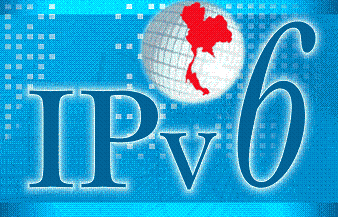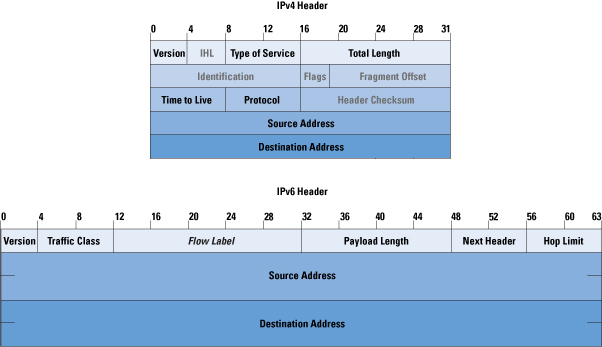The Future of the Internet: IPv6
From Computing and Software Wiki
The internet has been growing and expanding exponentially since its creation. The internet has become an integral part of business, communication and academic environments. IPv4 is the standard for internet communication and there are some underlying design flaws that the original architects of IPv4 did not account for. With exponential growth IPv4 is experiencing problems incorporating the number of new users and demands. This problem was addresses with the creation of the new protocol IPv6. IPv6 was created to solve the problem of a diminishing number of available IP addresses. IPv6 also addresses several security issues that were overlooked at the inception of IPv4 and improves routing efficiency, traffic bandwidth and address allocation. These improvements are required for the increasing strain new applications and increased traffic imposes on the current infrastructure. IPv6 was created to allow a seamless transition from IPv4. This feature allows organizations and individuals to upgrade to IPv6 as necessary and still communicate with users working with IPv4.
Contents |
What is IPv6
IPv6 stands for Internet Protocol version 6. It is the successor to IPv4 which is currently the backbone of the internet infrastructure. The Internet Protocol is the dominant network layer protocol on the internet. It is used along with other higher level protocols such as TCP and UDP to create connections across the internet to enable information sharing. It would make logical sense to assume they IPv5 would be the successor to IPv4, but IPv5 was created as an internet stream protocol for audio and video. The project was never widely distributed and now we are waiting for IPv6 to emerge as the standard.
Why Create IPv6
The IPng (Internet Protocol next generation) was established in 1994 to create a new protocol that would solve some of the issues that plague IPv4. The main improvements to IPv6 would be an increased address space. IPv4 uses 32-bit addressing scheme which allows for 2^32 unique addresses. Each machine attached to the internet requires a unique IP address, with an increasing number of people and machines using the internet these addresses will eventually be exhausted. IPv6 not only corrects the lack of address space it also enhances routing efficiency, increases bandwidth capabilities and provides better security.
IPv6 v.s. IPv4
Figure 1: IPv4 and IPv6 headers
(Source: van Beijnum, 2008)
The main difference between IPv4 and IPv6 headers is the size, but there are a few modifications made to the IPv6 header. A link to the specific differences can be found in the reference section.
Address Space
The limited number of available addresses with IPv4 was the main motivation for creating IPv6. IPv6 operates on a 128-bit addressing scheme instead of a 32-bit scheme. The IPv6 addresses are typically composed of two logical parts: a 64-bit (sub-)network prefix, and a 64-bit host part, which is either automatically generated from the interface's MAC address or assigned sequentially. IPv6 addresses are normally written as eight groups of four hexadecimal digits, where each group is separated by a colon (:). For example, 2001:0db8:85a3:08d3:1319:8a2e:0370:7334 is a valid IPv6 address.
If one or more four-digit group(s) is 0000, the zeros may be omitted and replaced with two colons(::). For example, 2001:0db8:0000:0000:0000:0000:1428:57ab can be shortened to 2001:0db8::1428:57ab. Following this rule, any number of consecutive 0000 groups may be reduced to two colons, as long as there is only one double colon used in an address. Leading zeros in a group can also be omitted (as in ::1 for localhost). Thus, the addresses below are all valid and equivalent:
2001:0db8:0000:0000:0000:0000:1428:57ab
2001:0db8:0000:0000:0000::1428:57ab
2001:0db8:0:0:0:0:1428:57ab
2001:0db8:0:0::1428:57ab
2001:0db8::1428:57ab
2001:db8::1428:57ab
Address Allocation
IPv4 addresses are allocated by network class. IPv4 classes are rigid and have not been created efficiently causing a shortage of addresses. The rigid structure also makes assigning addresses to organization and individuals inefficient creating a need for subnetting. IPv6 assignment protocols have not been fully developed but the idea will be to assign every organization, home or entity its own /48 bit prefix. This will allow for a 16 bits for subnetting if necessary.
Fragmentation
Fragmentation occurs when a packet or datagram is too large for the transfer bandwidth of the physical hardware. The packets are split at the router connected to the link that does not have enough bandwidth for the packet. Packets are fragmented when necessary and the path they take to the destination does not matter. IPv6 has fragmenting but it is done at the source instead of at the routers. This is possible because IPv6 determines the route before it sends the packet and fragments accordingly. This creates overhead for the sender but since routers are the bottle neck for transmitting information across the internet it is believed that if routers are only responsible for forwarding and not fragmenting this will increase the overall speed of the internet.
Maximum Transfer Unit
The maximum transfer unit is measured in bytes and is 576 for IPv4 and 1280 for IPv6.
Security
IPsec, the protocol for IP network-layer encryption and authentication, is an integral part of the base protocol suite in IPv6; this is unlike IPv4, where it is optional (but usually implemented). IPsec, however, is not widely used at present except for securing traffic between IPv6 Border Gateway Protocol routers
Integration
Due to a varying need for efficiency and speed the transition from IPv4 to IPv6 will be a long process. IPv6 has been designed to operate alongside the existing IPv4 infrastructure. This is possible due to the use of tunneling IPv6 packets within IPv4 packets. The IPv6 packets will use the IPv6 networking infrastructure where it is place but when there in a section that is only operating IPv4 the packet from version 6 will be encapsulated within the IPv4 packets transferred over the IPv4 network and then use the IPv6 infrastructure when it is again available.
See Also
Alternative Technologies for Ethernet
Secure Electronic Transmission (SET) Protocol
SSH Tunneling
The Great Firewall of China
Computer Network Traffic Shaping
Referneces
"Compare IPv4 to IPv6".iSeries Information Center. http://publib.boulder.ibm.com/iseries/v5r2/ic2924/index.htm?info/rzai2/rzai2compipv4ipv6.htm
http://www.ipv6forum.com/
http://www.ipv6.org/
van Beijnum, I.,2008. "IPv6 Internals". The Internet Protocol Journal, 9:3. Retrieved at http://www.cisco.com/web/about/ac123/ac147/archived_issues/ipj_9-3/ipv6_internals.html on April 13,2008
"Thailand IPv6 Forum". Retrieved at http://www.thailandipv6.net/ipv6thaisite.htm on April 13,2008
External Links
IPv6-Wikipedia
IPng Current Specifications
Compare IPv4 to IPv6
--Schulza 22:16, 13 April 2008 (EDT)


